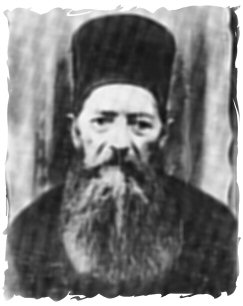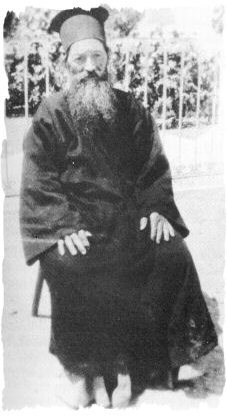Panagia Vlahernon Greek Orthodox Monastery
St. Savvas the New of Kalymnos
 One
of the major feast day celebrations at our monastery is the
feast of
St. Savvas the New of Kalymnos. His feast day
is celebrated
twice annually: December 5 and the 5th Sunday of Great Lent.
One
of the major feast day celebrations at our monastery is the
feast of
St. Savvas the New of Kalymnos. His feast day
is celebrated
twice annually: December 5 and the 5th Sunday of Great Lent.St.
Savvas the New is the patron saint of the Greek Island of Kalymnos,
where he lived during the last twenty years of his life as the priest
and spiritual father of the nuns of the Convent of All Saints.
He was
a great ascetic, confessor, iconographer and miracle-worker. He is one
of the recently recognized saints in the Orthodox Church.
Saint Savvas was born in 1862 in Eastern Thrace and was baptized with the name of Vasilios. From a young age he had a calling for the holy monastic life and so he left for Mount Athos as a teen where he entered St. Anne's Skete. Along with the usual monastic duties, he learned iconography and Byzantine music.
After a few years, he traveled to Jerusalem for a pilgrimage to the holy sites, and there he entered the monastery of St. George Hozevitou. After a period of being a novice, he was tonsured a monk and given the name of Savvas.
In 1902, St. Savvas was ordained a deacon and a year later he was ordained to the Holy Priesthood. He spent almost 10 years in the
 desert by the Jordan where he led
an
austere life and occupied himself with
prayer and iconography. His
dwelling consisted of two cells which he reached by ascending up a rope
ladder. This isolation was necessary for successful inner
concentration and noetic prayer and he made great spiritual progress
there.
desert by the Jordan where he led
an
austere life and occupied himself with
prayer and iconography. His
dwelling consisted of two cells which he reached by ascending up a rope
ladder. This isolation was necessary for successful inner
concentration and noetic prayer and he made great spiritual progress
there.Due to health reasons and the political situation in Palestine which made life unsafe, St. Savvas returned to Greece where he searched for a quiet place to continue his monastic life. He traveled throughout Greece for three years but could not find a suitable place. His prayers were answered when another saint, St. Nektarios of Aegina, had asked St. Savvas to come to the Holy Trinity Convent in Aegina and serve as a priest for nuns. There he would also be able to teach them the sacred art of iconography and Byzantine music. St. Savvas stayed at the convent for six years, from 1919 until 1925. This time at the Convent was one of the most significant events in the saint's life due to his association with St. Nektarios who was at the height of his spiritual development. St. Savvas had the opportunity to confess and receive counsel from St. Nektarios. The two had the highest esteem for each other and each considered the other a saint. As a matter of fact, St. Savvas painted the first icon of St. Nektarios: One day St. Savvas asked the Abbess not to let anyone disturb him for forty days, during which he remained confined to his cell. After 40 days, he came out of his cell holding an icon of St. Nektarios. He handed it to the Abbess and asked her to place it in the church for veneration. The Abbess was surprised since St. Nektarios had not been glorified ("canonized") as a saint yet and she was afraid that the convent would get into trouble. Although the saint was always meek and humble, he insisted, and told her in a commanding manner: "You must show obedience. Take the icon and place it on the icon stand, and do not scrutinize the will of God." He knew the holiness and purity of St. Nektarios.
After St. Nektarios reposed, more and more pilgrims would come to the convent due to the growing reputation of St. Nektarios as a miracle-worker. This disrupted the quiet life that St. Savvas loved and so he departed the convent in 1925, again for a quieter life.
St. Savvas spent the last years of his life as the priest and spiritual father at the Convent of All Saints on the island of Kalymnos. As a confessor, he combined leniency with severity. He was lenient on certain sins and severe to others. He remained an ardent spiritual striver until the end of life and practiced extreme forms of self-restraint with regard to food, drink and sleep. St. Savvas became a shining example of virtue to all who came into contact with him. Many smelled a heavenly fragrance in his presence and some even saw him rising above the ground as he stood at prayer.
Towards the end of his life, St. Savvas was in a state of intense concentration and holy contrition. For 3 days he did not receive anyone and he gave his last counsels: requested love and obedience in Christ. When he was on the point of death taking his last breath, suddenly he received strength, brought his blessed small hands together, and clapped them repeatedly saying his last holy words: "The Lord! The Lord! The Lord!". He went to the Lord in 1948 on the eve of the feast of the Annunciation. One nun saw the soul of the saint ascending in a golden cloud towards heaven. After about 10 years when the saint's grave was opened in accordance to the Greek Orthodox custom, a heavenly fragrance emanated from the grave and this was witnessed by many, including the local bishop. This was a testament to the sanctity of the saint. Numerous miracles and healings have since been attributed to St. Savvas the New of Kalymnos.
Through the intercessions of St. Savvas the New, have mercy on us O Lord and save us! Amen.
Apolytikion
Let us faithful praise Holy Savvas, the glory and protector of Kalymnos,
and peer of the Holy Ascetics of old; for he has been glorified resplendently as a servant of Christ,
with the gift of working miracles, and he bestows upon all God's grace and mercy.
Kontakion
Today the island of the Kalymnians celebrates your holy memory with a rejoicing heart;
for it possesses as truly God-given wealth, your sacred body that has been glorified by God,
O Father Savvas, approaching which they receive health of both soul and body.
Megalynarion
Rejoice thou new star of the Church,
the offspring of Thrace and the beauty of Kalymnos,
O God-inspired Savvas, fellow citizens of angels
and equal of all the saints.
Let us faithful praise Holy Savvas, the glory and protector of Kalymnos,
and peer of the Holy Ascetics of old; for he has been glorified resplendently as a servant of Christ,
with the gift of working miracles, and he bestows upon all God's grace and mercy.
Kontakion
Today the island of the Kalymnians celebrates your holy memory with a rejoicing heart;
for it possesses as truly God-given wealth, your sacred body that has been glorified by God,
O Father Savvas, approaching which they receive health of both soul and body.
Megalynarion
Rejoice thou new star of the Church,
the offspring of Thrace and the beauty of Kalymnos,
O God-inspired Savvas, fellow citizens of angels
and equal of all the saints.
Adapted from Modern Orthodox Saints Vol. 8 - St. Savvas
the New by Dr.
Constantine Cavarnos,
Institute for Byzantine and Modern Greek Studies
Institute for Byzantine and Modern Greek Studies